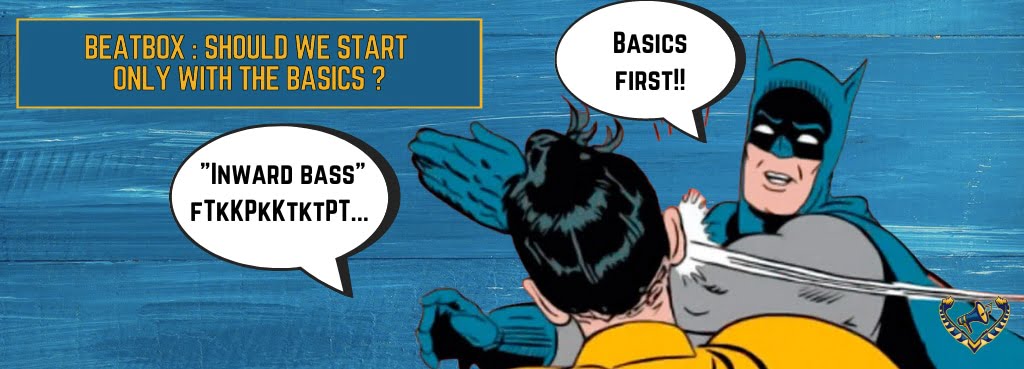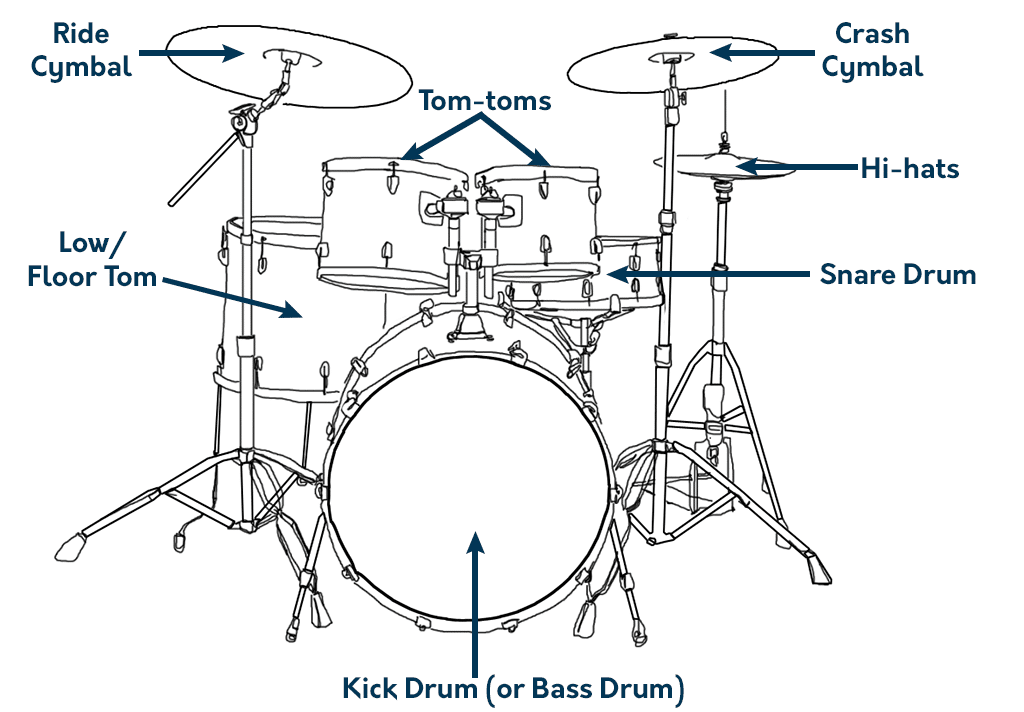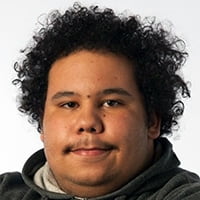
Beatbox: Should we only start with the basics?
We often hear “Learn Basics First”, “Before learning lipsroll or inward bass”. As obvious as this formula may seem, has this practice really proved its effectiveness?
What are the “basics” in Beatbox?
To find what we are looking for, we need to know what we are looking for. As well as knowing what we are talking about, it is important to define what the “basics” are.
The basics in beatboxing are often related to the basic percussion sounds, namely the following sounds:
- The Kick Drum (P)
- The Hi-hat (t)
- As well as the snare drum often called: The Snare (Pf) or (K) for the Rimshot
At an advanced level, there are many snare drums that I won’t mention because the list would be too long (perhaps this will be the subject of a future article!).
At a beginner’s level, there are also several types of snare drums which we will mention:
- The Outward K snare (there are several variants too)
- The Inward K Snare
- The Pf Snare
To give you an idea of what sounds we’re talking about, you can watch this introductory course on beatboxing basics by FootboxG. It’s available for free.

The role of a beatboxer
The beatbox is the art of making music with your mouth. It involves imitating instruments such as drums, trumpet, scratch or any instrument of your choice. As beatbox has evolved, making up sounds can also be considered as an integral part of the discipline.
We don’t often hear that learning sounds with melodic use such as trumpet, saxophone or bass is a solid foundation when starting out in beatboxing. This may be due to the fact that it is more difficult or takes longer to learn than percussive sounds.
But keep in mind that a beatboxer is a versatile musician: he or she is a rhythmist, vocalist, composer, imitator and instrumentalist.
The concepts to know in Beatbox
As the beatboxer is a versatile musician, it means that it’s highly recommended to know the basic musical concepts. These concepts are:
- Tempo, beats and bars/metres, rhythm for the rhythmic aspect
- Scales, notes, musical intervals and chords for the melodic aspect. This turns out to be VERY important when working in a group (tag-team, crew or with other musicians: singers or instrumentalists but also other artists: dancers, football freestylers, …)
- Cleanliness of sound. This criterion is specific to beatboxing. You will work on your sounds so that they are clean and well executed. This means that your kicks, hi-hats or snares must be consistent in terms of volume and quality.
Drummers, guitarists, pianists, singers and other instrumentalists learn these concepts, so why not beatboxers?
Some will say that theory is useless and that nothing beats practice. You are free to choose this mode of operationpractice. Indeed, you can work on your musical ear in many different ways. Some musicians don’t know anything about music theory, but they are still not bad musicians.
The beatboxer is also a “sound designer”. This one will hear sounds and reproduce them with his mouth. It is therefore naturally important to balance his frequency spectrum, but this is a more technical area that would deserve a full article on the subject.
Did your favourite beatboxers really only start with the basics?

Synopsys:
“I started beatboxing only with drum sounds.”
FootboxG:
“In the first place, I would like to say that you should not only start with the basics. However, the basic sounds are the most important.
I would recommend to explore as much as possible and to have as much fun as possible too, which can happen by trying out advanced beatbox tricks!
If you work in a disciplined way, I would recommend focusing on the basics first, and then moving on to more advanced techniques such as bass or effects.
When I first started beatboxing, I tried impossible techniques and I had a lot of fun trying these out and experimenting. But I realised that the more I wanted to compete in serious competitions, the more my basics were SUPER important.”


Alexinho:
“It’s all relative, it depends on what you want to do with Beatbox. Do you want to get into the battle scene, the concert scene? Or both?
So yes, I think it’s essential to learn the sounds that allow you to create rhythms and certain music genres.
After that, there are more particular cases and I am thinking in particular of Michael Winslow who specialised in the sounds of everyday life.
But for Beatbox as a battle, or Beatbox as a musical tool, I think it is necessary to learn the basic sounds and rhythms. There are different ways to understand them, to grasp them and to perform them!”
Alem:
“To the question “Should we only start with the basics of beatboxing?”, my opinion is divided! I will say yes and no.
Why yes? Yes, because having a solid foundation (drum sounds) isit’s very important when you start beatboxing.
On the other hand, I also want to say no. Learning original sounds when you don’t know to beatbox it’s great. Let’s take the following example:
Imagine someone who starts beatboxing more with FX for a year rather than percussive sounds (“FX” is short for “effects”. This includes sounds from everyday life, sounds that can represent anything and everything), and then learns the basics. This beatboxer will have a wide range of “FX”. And I know beatboxers who started out that way. They had little or no rhythm in the beginning, but they had a lot of FXs.
Conversely, take someone who starts with just the basics for a year. He will probably have little or no originality. Was it right to learn only the basics at the beginning? Answer: I don’t know, it depends on the objective.
Do you want to compete? If so, the question would be: “Should you only start with the basics if you want to compete in a championship in the next two years?”
It all depends on your objective. It is the goal that will determine the importance of starting with the basics only, or with other sounds.
If the objective is to do a concert, to hold a rhythm, to do the French championships, for me it is necessary to start with the basics only because it is very important to know how to hold a rhythm.
On the other hand, if the objective is to have fun, you are free to choose to learn the sounds that you are craving to learn. It can be FX, imitate everyday sounds”


BigBen:
“My personal experience and what I recommend are different.
Let me explain:
When I learn something, I like to work on it long and hard. It’s not what I recommend and it’s just the way I work, that’s what I like.
What I recommend is to practice the basics (kicks, hi-hats, snares) every day, but I also think that most of the time should be spent discovering new things and there are two reasons for that:
- You increase your creativity by discovering and experimenting with things.
- Physically, your mouth needs to make as many movements as possible. Doing lots of things from the start increases dexterity and allows for better muscle learning to learn more complicated sounds in the future!”
Enjoy yourself, but don’t neglect the basics
As mentioned before, we often hear “Basics first”. It’s true, the basics are essential to start beatboxing and not get stuck at some point in the future.
However, if a sound or technique appeals to you, don’t hold back from learning it just because you have to learn the basics first. The learning process should remain a pleasure and not a chore!
That said, this is not an excuse to jump on super complex sounds or techniques without developing your rhythmic faculties and the cleanliness of basic sounds!
If you want to learn more, you can visit the main Lyrebird page. You will find a wide variety of resources there!

Your vision of beatbox
Your learning will also depend on how you see beatboxing. Do you see it as a musical or even a sporting performance? Do you consider the musical side more important than the rest? Or just a mix of both? It’s up to you to think about it. Tell us in comments!
Don’t forget that beatboxing is not only a battle discipline and that there are musical projects with beatbox in France and in the world!
Here is one of them:
Things to remember
- Prioritise the learning of the basic percussive sounds namely: Kick, Hi-hat, Pf Snare, Outward K and Inward <K
- Don’t neglect the melodic aspect: practice reproducing melodies with your voice, by humming, and if you are learning an instrument sound like the trumpet, you can also practice reproducing melodies on the trumpet.
- Enjoy yourself, if you like a sound or a technique, go for it! Don’t rely on people telling you to “stop learning this and get back to your basics!”. A kind piece of advice would be “It’s great that you’re learning this technique! That said, I think your snare lacks power (or cleanliness), you should work on it!”
And you, what is your experience? How did you start beatboxing? Tell us in the comments below!
Thanks for reading the article!




Responses